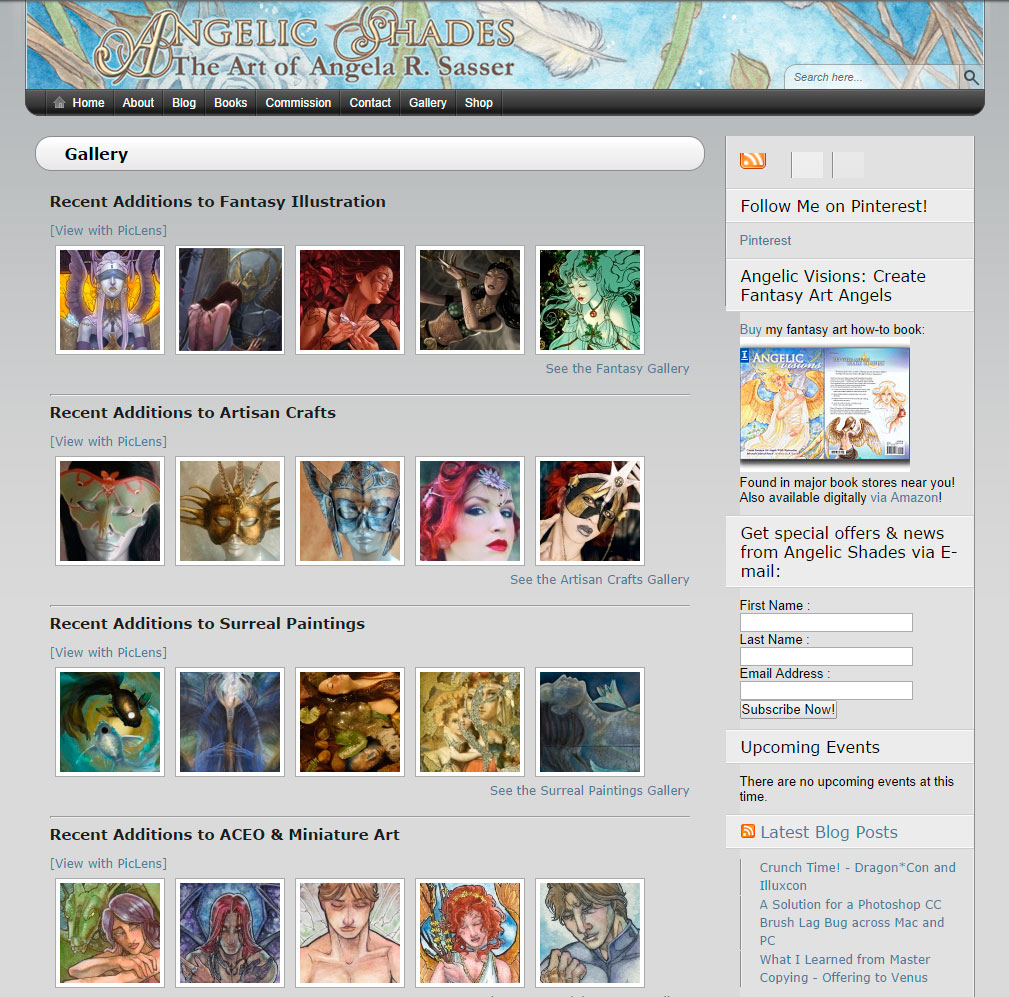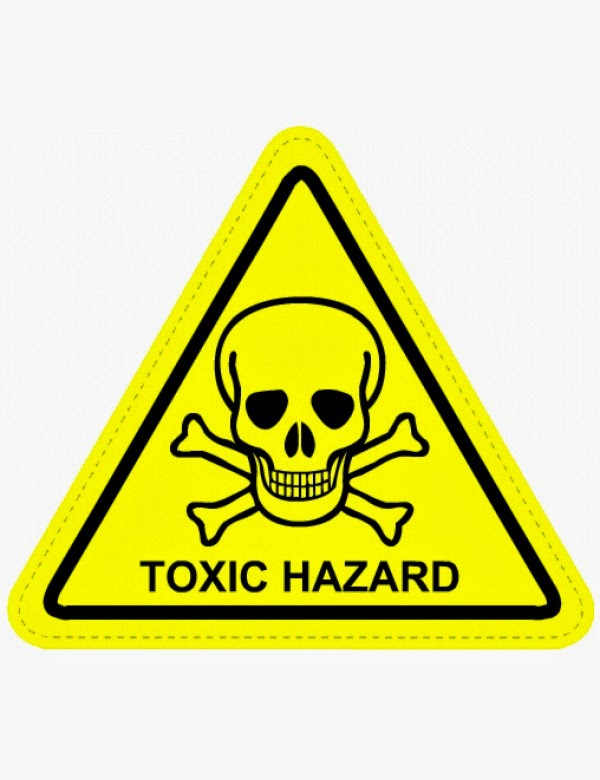So, you like drawing, but also painting, writing, candle-making, and beading? I know how you feel! Being multipassionate seems to be a habit of most of the creative people I know. Our minds like to wander and play and that’s part of how we keep ourselves creative!
However, this characteristic usually leaves most of us with a huge problem – an unclear sense of artistic identity and, therefore, an unclear brand.
I’ve had this problem for years and it’s only been until recently I’ve sat down and put a magnifying glass to my brand. For example, just look at the mess that was my website last year. I had masks, Art Nouveau, surreal work, miniature work, sculpture, anything and everything all thrown together on my site:
 |
| My Angelic Shades site back in 2013. |
After discussing my fractured identity with fellow artists and a friendly Art Director, I realize that this Anything and Everything approach was really killing my sales and my presentation.
What an AD might think:
“She has so many styles! She must still be a student and probably isn’t very reliable. She hasn’t quite mastered anything.”
What an average person might think:
“Wow, this is all really cool! But later on, I probably won’t remember what it is exactly she’s selling.”
Echo this sentiment for selling at conventions, too. After seeing all the masks, art, etc. at my table, most people aren’t sure what I’m selling or if it’s all by one person, since the themes differ so vastly. This also made my sales pitches extremely complicated, as I wasn’t sure how to address all of the products on the table.
Or my other favorite.
“Wow, this is cool! I’m going to ask this person for a commission that she’s not necessarily interested in doing because she’s obviously interested in doing everything and is very versatile.”
In truth, I’d actually prefer it if people ask me for work that I specialize in, rather than work that I don’t specialize in. Most of the time, the work I don’t specialize in doesn’t go into my portfolio and is never seen again.
The Tough Questions
I had to start asking myself some important questions and coming up with answers that faced my fears as an artist. These burning questions have been on my mind for a long time now:
What am I passionate about and what is just fun to do?
A lot of people think ‘hey it’d be fun to make my hobby a job!’ but what they don’t realize is that once you make your hobby your job, it’s not fun anymore. If you turned to that hobby for recharging and relaxation, chances are that being forced to do it for monetary purposes is going to destroy that sense of fun and play you had with it. You’ll most likely have to get another hobby now that the last hobby has become the job.
My Answer: I realized over the past few years that Art Nouveau and soft watercolor work is my ‘fun’ art. So is mask-making. I turn to these modes of expression to refresh my creative well. Making them my job meant I had less time in my life for the mature fantasy work I am passionate about. Admittedly, the money is nice and that also swayed me towards these other forms of expression. This choice of splitting focus resulted in much burnout over the past couple of years.
My art as a body of work has so many facets. What should stay and what should go?
Think about what target audience there is for your work. Does your work actually target the same people? Did you do something for random fun but it just doesn’t fit in with your other work?
Sometimes it’s just better to leave things off of your professional face for storage on something more casual, like tumblr. Keeping unrelated work can make you look like a student or unreliable in your ability to finish consistent work. Stop thinking of what is your ‘best overall work’ and starting thinking ‘what is your best work for what specific audience’.
My Answer: For me, I ended up dumping the ACEO and Surreal sections from my site. These works were all older and I’m not exactly interested in being hired to work in that vein anymore. On the other hand, I still wanted to share my artisan crafts and Art Nouveau, as I’ve put many years into them and still find them as viable professional faces to share.
And thus my brands Angelic Artisan and Angela Sasser were born! Angelic Shades is my original studio name, which will now be purely for the work I created for my book, Angelic Visions, and for my Art Nouveau work.
My mature fantasy work is going to be housed on a new site that I’m currently working on (sneak peek here!). Angelic Artisan has also been moved off to its own cozy website dedicated solely to my artisan crafts (a move which happened last year, actually).
I chose my real name as a studio identity because I feel like this brand is finally me. I have found MY voice and what I feel is going to be the artistic identity I want to become known for. Another perk to deciding what my ‘main’ identity/studio is going to be is that I now realize where the majority of my time needs to be spent.
Angelic Artisan and Angelic Shades will both now be downgraded to side projects that I only do for fun. This is a huge weight off me and one that I feel will allow me to focus my time on my passions instead of being torn between too many tasks. It’s going to be hard saying no to the commissions that come in for artisan and Art Nouveau work, but decreasing my stress levels and focusing on my long-term goals is what needs to happen for me right now to stop feeling so overwhelmed by the tasks ahead of me.
Bonus perk – my sites just look sooo much more beautiful and professional now that they have ‘themes’!
Since I am re-branding mid-career, how do I mitigate changing my identity in the face of collectors and AD’s?
This one is my toughest question right now. How do I change what I’m doing so that people won’t be upset by my switch of direction? Most of the other multifaceted artists I’ve talked to worked to become known for one thing and earned the respect of AD’s and their market before they branched out. They were stabilized by the fact their fans would follow them and that they still have the respect of AD’s whom they have proven their reliability to in the past.
My problem is I got good at one thing I realized later on is not the thing I want to be known for. I’m not sure if I’ll be burning bridges doing this. It’s quite intimidating!
My Answer: Right now, my plan is to completely break my art styles up into Angelic Shades and Angela Sasser with their own corresponding sites and outlets so that when I hand a business card out to an AD or anybody else, the linked site on each unique card will present a consistent body of work with a clear theme.
As for AD trust, I will probably only be showing AD’s my Angela Sasser brand, unless their projects specifically call for soft watercolors and/or Art Nouveau stylings. They shall never know my secret identity as a soft flowy watercolorist and mask-maker!
I have no idea what this means for my social media faces, however! I’m so entrenched in the Angelic Shades username that I’m not sure if people will actually follow me to a new name, if I start one. Brand consistency for ‘Angela Sasser’ demands a new Twitter, Facebook page, blog, etc. I’m not sure I’m going to do this yet, but you will be the first to know!
STOP! Do you really want to do this? Are you just messing up a good thing?
If you’re doing well as you are and enjoy what you’re doing, maybe you should just leave well enough alone?
My Answer: It’s taken me many years of struggling and burnout to realize I’ve invested my time in the wrong places because I was more focused on making money than taking the risky path and following my passions in illustration and concept art. I was afraid and didn’t trust myself. I let bad advice and pressure from loved ones dissuade me from focusing on what I really wanted to do. I also didn’t really have an idea of where I wanted to go back then, so I did what was fun and acceptable.
Just because you might be capable of creating something that someone enjoys and will pay money for doesn’t necessarily mean that’s what you’re meant to do, especially if your heart lies elsewhere.
Knowing all this, I feel my mistakes have helped me to refine a laser focus I’m looking forward to implementing now that I’ve identified where my heart truly lies. It’s only through experiencing these early struggles that I know myself better and can look forward to the future with more confidence!
Reader Questions:
Do you have multiple creative businesses? How do you handle running them all at once? Share your tips in comments!
Next Up: Part 2 – Brand Design
